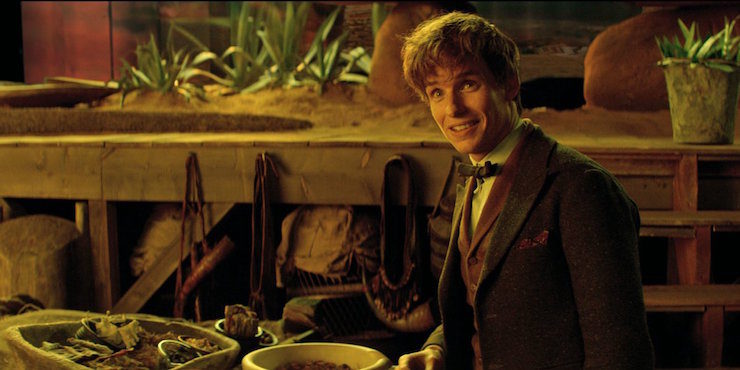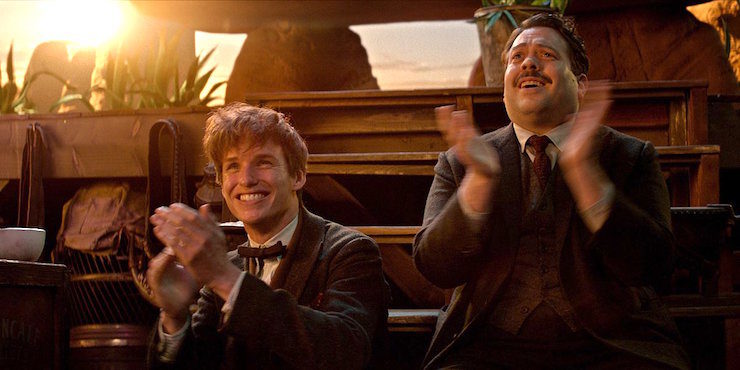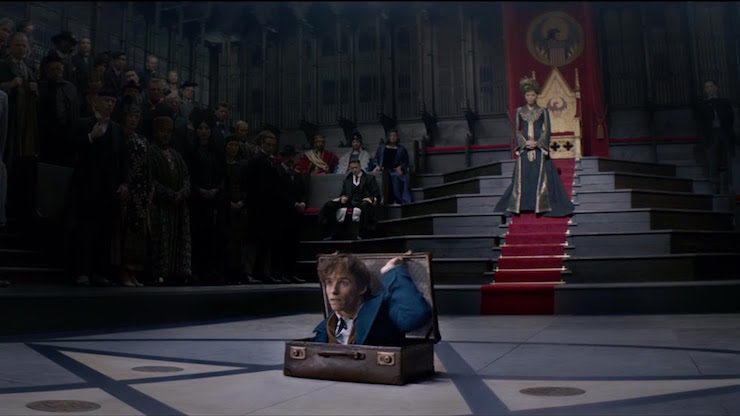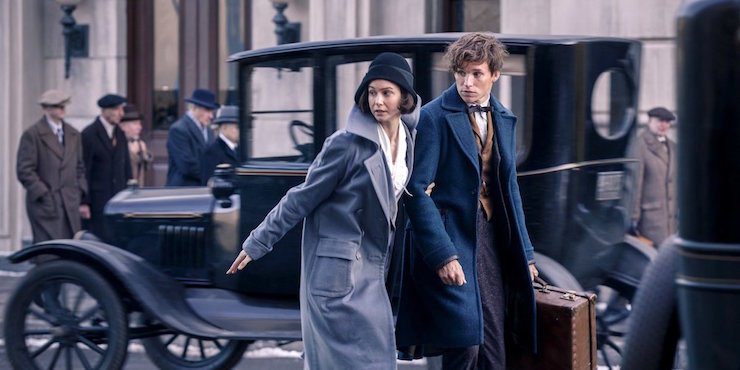It’s easy to be of two minds about Fantastic Beasts and Where to Find Them… because it seems very much like two movies. They blend together, sure enough, but they’re still staggering side by side. Viewers who thought they were in for a fun romp with cute CGI magic creatures will be pleased that a good half of the film is certainly dedicated to that. But there are much darker underpinnings to this tale that provoke all sorts of questions about Rowling’s wizarding world, and what sort of past it heralded from.
[Spoilers for the film below.]
On the surface it’s quite a simple story: Newt Scamander comes to New York with a suitcase full of magical creatures for the purpose of returning one of them to its natural habitat. Several of those creatures get loose and run amok in New York City, which is mostly a problem because the magical community is kept quite separate from the NoMaj community in the U.S., and the MACUSA (that’s the Magical Congress of the United States of America) is deeply displeased with the turn of events. Newt befriends a former Auror Tina and her sister Queenie, as well as a NoMaj named Jacob–also a problem because non-magic folk in the United States are not permitted any knowledge of the magical world. They work together to collect said magical creatures and get caught up in a plot by MACUSA official Mr. Graves, who is trying to harness the power of an Obscurial; the embodiment of a magical child’s repression when they are forced to hide their abilities.

Eddie Redmayne is utterly charming as Newt Scamander, a sort of Steve-Irwin-for-the-magical-world-meets-the-Doctor type character. While he was in danger of falling into the trap of many heroic figures these days—special guy who happens to be better at [insert really important thing] than everyone else, but terrible with people, but that’s okay because his skills are all that matters—Scamander avoids this issue by being a genuinely likable, loving person. His difficulty with people isn’t an affectation, pretense, or preference; he really does have a problem connecting because he really does understand animals better than humans. We can still say that he did something incredibly reckless by bringing an entire zoo’s worth of magical creatures into a new environment for the sake of transporting one, but at least he isn’t dismissive and demeaning of other people. He’s just not good at relating to them, and needs a bit of time to do so. (Fans often create theories backed up by near-dissertations full of material to support the idea of characters like Sherlock Holmes being on the autism spectrum, but I think that you could make a better case for Newt because it seems as though Redmayne is intentionally playing him as such. For example, he practically never looks others in the eye unless he has come to trust them, and only truly opens up around his menagerie of creatures, where he is comfortable and calm.)
Katherine Waterston brings more to the role of Tina Goldstein than is truly on the page, lending real vibrance to a character who is something of a staple in the Potterverse—a hyper-competent woman who is rarely recognized for her extreme dedication and good work. (It would have been nice to see her get a little more recognized by the end, to be perfectly honest.) Her sister Queenie is played with effervescent elegance by Alison Sudol, another character that Rowling continues to offer wonderful variations upon—a personification of stereotypically “feminine” strengths, full of empathy, kindness, and loyalty. And finally, Dan Fogler gives a lovely turn as Jacob Kowalski, a sensitive soul who just wants to spend his life baking rather than dying slowly working at a cannery. (I admit a personal soft spot for his portrayal, having seen Fogler play Barfée on Broadway in 25th Annual Putnam County Spelling Bee. It’s wonderful to see him get such a fun role.) All in all, the entire cast gives a commendable show of it, doing their best to fill in whatever gaps the plot provides with as much gravitas as possible. With the exception of Jon Voigt, who’s presence is just kind of there and jarring and grumpy.

The magical creatures themselves are gorgeous, and largely impressive on the CGI front. They provide most of the humor and heart of the tale, which might have been a tall order for animated stock, but they do an excellent job striking wonder into the hearts of all. It seems likely that fans will develop a renewed interest in Care of Magical Creatures going forward, and everyone is going to want their own niffler or bowtruckle. Newt’s interaction with the animals makes for a beautiful sidetrack in the narrative, and helps the audience to connect with a character who was only previous known in a sparse, short book as part of a set Rowling created for charity.
The pacing is actually surprisingly measured for a blockbuster, making the overall experience more enjoyable. While there is still ultimately too much information to fill up a film, the script’s departure from your standard opener-setup-battle-downtime-largerbattle-denouement makes it more intriguing to watch. The costumes are stunning down to every little detail, and getting to see an older New York City is a treat all by itself. The score, provided by James Newton Howard, honestly sells the whole movie and they’re very lucky to have him on board. It is exciting to see a story set in the wizarding world that is full of adults, as well. All of Rowling’s stories thus far have rotated around children and teenagers, and watching the central characters form such strong bonds as older people is a welcome spin on familiar themes.

There are darker forces at work, of course, and these aspects of the story might come as a shock to more casual viewers who assumed that they were in for a fun, silly flick. For example, Rowling’s conceptualization of a magical “death penalty” (a likely jab at the U.S. where capital punishment is used in 31 states as of this writing, seeing as Great Britain hasn’t employed capital punishment since 1964) is horrific in the extreme, taking place in a seemingly benign environment that warps into the stuff of nightmares. The concept of the Obscurial itself is a tragic thing, and young Credence’s history of trauma and extreme abuse are incredibly difficult to stomach alongside all the whimsy and magic. It seems likely that these injustices will have a much larger role to play going forward (seeing as there will be four more films), but having us introduced to these issues at the same time as our lively core quartet is tonally odd to say the least.
If your only concern is an entertaining film with a superb cast, it is sure to delight. On the other hand, Fantastic Beasts is also a film with plenty of gaps and areas of neglect, many that were suspected by fans going in. For starters, New York City of the 1920s shows the magical community to be relatively diverse, but once you’re on the streets of NoMaj New York, the city is incredibly white. Where Rowling’s worldbuilding for the wizarding world was already shaky, it shows—immense property damage seems reversible with the wave of a wand on a scale we have never encountered before, very few characters actually say spells out loud when performing them, whole meals come together in a matter of seconds when it took Molly Weasley hours, Newt seems to have an entire dimension in his suitcase which begs the question of how critically we can cast an eye on other similar situations from the Potter series (like the Quidditch tents that Harry and Co. camp out in versus Hermione’s handbag full of books and supplies). We never find out if house elves are free in America, which seems too relevant to overlook. The problematic background given to Ilvermorny school was not needed for this film to take place at all—the school is only name-dropped once in the entire jaunt. The movie’s ending leaves us with the old bait-and-switch of allowing the audience to get teary over Jacob’s potential fate, then backpedals even before the credits have rolled, begging the question of why that path needed trodding in the first place.

Colin Farrell’s excellent turn as Mr. Graves is yanked right out from under him in the final reveal. While the twist is a hallmark of Rowling’s, in this case it doesn’t feel earned and actually points out several places that the narrative never fills in—how long has Graves been working at the MACUSA? Was he an actual member who Grindelwald killed and took over for, or did Grindelwald actually insinuate himself into the American Congress as another man? The truth is, reveal aside, Mr. Graves is a far more interesting character if he’s not Gellert Grindelwald in disguise. Someone who has begun ascribing himself to similar ideals because he perceives an imbalance working against American wizards is a far more fascinating villain. Instead, we’re left with an odd cameo to set up more films. (Then there’s the issue of casting Depp as Grindelwald in the first place given the evidence of his abuse toward ex-wife Amber Heard, which deserves more attention that I can offer it here.)
While the film itself is fun, its place in the wizarding world continuity requires some more thought overall. It’s a wobbly addition to the universe as a whole, and while the forthcoming movies are bound to shed some light on certain unanswered questions, it seems doubtful that every single loose thread will get tied up by the end. If you are a stickler for those details, you might find yourself a bit perturbed by the experience.

But if you’re just in it for the nifflers and bowtruckles, you’re bound to be a happy camper.
Emmet Asher-Perrin actually almost cried when Newt gave away his bowtruckle (however briefly) to Ron Perlman the elf. You can bug her on Twitter and Tumblr, and read more of her work here and elsewhere.










